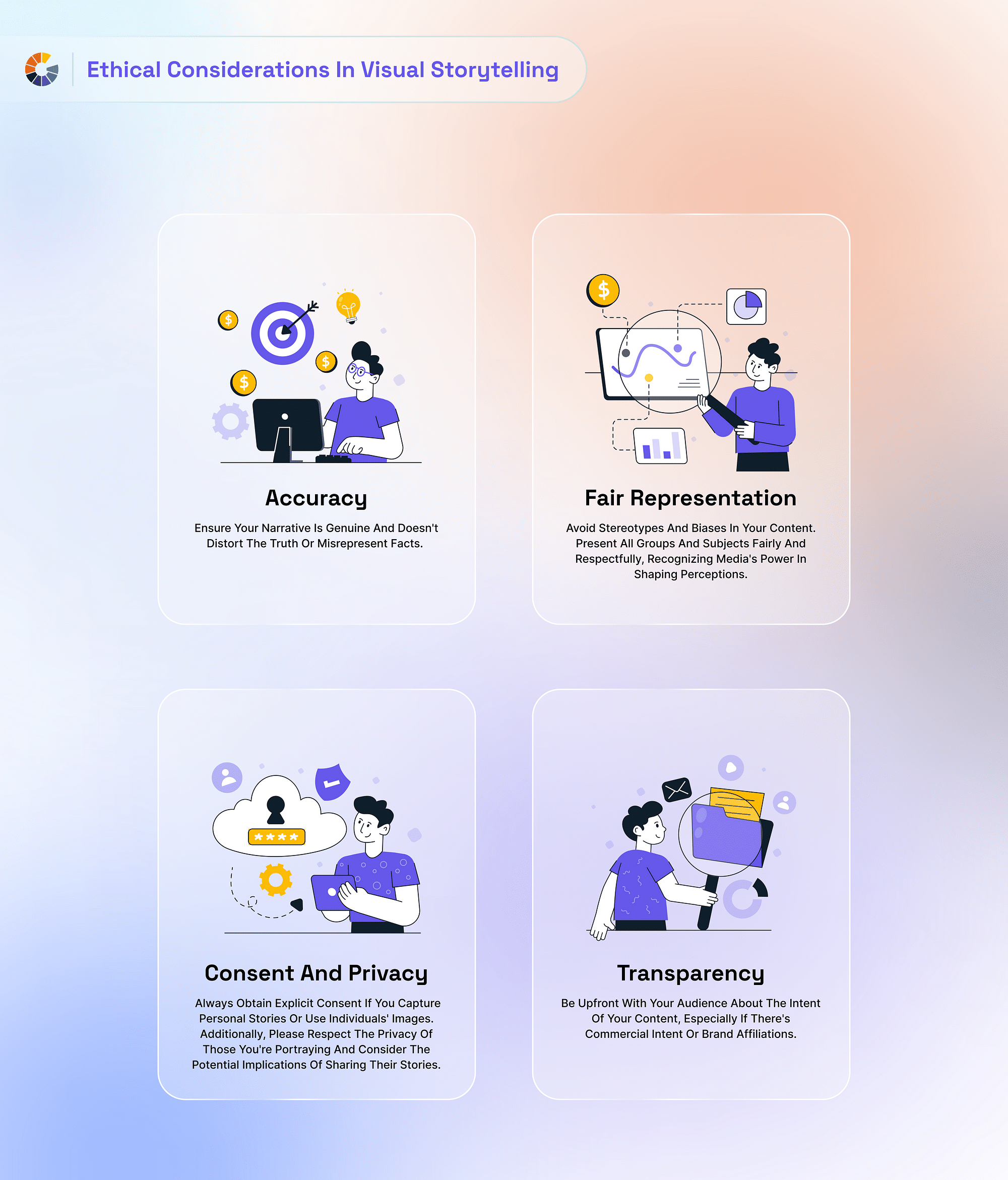What is Video Storytelling?
Video storytelling is the craft of using visual and audio mediums to narrate a tale or convey an idea. Essentially, it is about creating a narrative using moving images and sounds, often enhanced with texts and effects. This could be as simple as a recorded anecdote from an individual or as complex as a full-blown commercial advertisement or a cinematic film. The key aspect of video storytelling is that it takes the viewer on a journey—eliciting emotions, provoking thoughts, and ultimately leading to a certain message or conclusion.
Schedule a Demo with Our Video Expert!
Discover how Gumlet can help you build a cutting-edge video streaming infrastructure.
Why is Video Storytelling important for a business/brand?
The art of storytelling is potent and inherently memorable, making it an effective tool for promoting a brand. Video storytelling can help brands permanently etch themselves in consumers' minds, but the reasons for integrating it into marketing strategy stretch beyond memorability.
Capturing and Retaining Audience Attention
The competition for audience attention is fierce in a world that generates approximately 2.5 quintillion bytes of data daily and with 500 hours of video uploaded to YouTube every minute worldwide. Amidst this overwhelming content saturation, video storytelling is a unique approach to capturing and holding the viewers' attention. According to Harvard Business Review, character-driven stories consistently stimulate oxytocin synthesis—a hormone produced when we are shown trust or kindness, fostering cooperation. Put simply, crafting an emotional narrative around a product or brand can effectively engage and captivate audiences.
Promoting Information Retention
Fact lists might be informative, but when presented as a story, they become more digestible and memorable. This is why major brands often leverage compelling storytelling in their video advertisements for new products, opting to intertwine features and benefits within the narrative rather than presenting them as a dry list. Such an approach facilitates information retention, making the brand's message more impactful. Apple is a prime example of a brand that skillfully incorporates video storytelling into its marketing campaigns.
Humanizing the Brand through Emotional Connection
Video storytelling also contributes significantly to humanizing a brand. People tend not to engage with impersonal, faceless corporations, and storytelling provides a way to show a brand's more human side. By leveraging the power of video storytelling, brands can connect on a personal level with audiences, fostering a sense of trust and relatability. This strategy allows brands to appeal to viewers' emotions, helping them visualize pain points and solutions rather than merely telling them. Through video storytelling, brands can achieve a deeper, more human connection with their audiences.
How to Make a Compelling Storytelling Video?
Developing an impactful storytelling video isn't simply a matter of pointing a camera and pressing the record. It requires meticulous planning, creativity, and a comprehensive understanding of your brand and audience. The process can be divided into key stages, each playing a crucial role in ensuring the final product's success. Let's delve into these stages and explore how they contribute to creating a compelling video story.
Set Clear Goals for Your Campaign
Begin your video campaign journey by clearly defining your goals. What do you hope to achieve with your video? What specific outcomes are you aiming for? Whether you need to generate leads, increase brand awareness, or communicate a new product feature, clarity of purpose should be the starting point.
Defining Brand Story
The brand story is the narrative that encompasses the facts and feelings that your brand induces. It needs to resonate with the viewers' values and emotions. Hence, before you begin, you must clearly understand what your brand stands for, its unique selling points, and its emotional appeal.
Understanding your Target Audience
Knowing your audience is paramount. It is about understanding their demographics, their motivations, their challenges, and the best way to reach them. This will help you craft a narrative that truly resonates and feels personal to them.
Craft Your Narrative and Write a Script
Choosing the type of narrative for your video is an essential step. You might opt for a linear narrative, where the story unfolds sequentially, or a non-linear narrative, where the story hops between timelines, adding an element of intrigue. Alternatively, you could choose a quest narrative featuring a hero striving towards a goal or a viewpoint narrative presenting various customer or employee perspectives. Once your narrative style is decided, draft a script that will serve as the backbone for your video story
Storytelling Video Production and Post-production
The production and post-production process involves the practical aspects of creating the video. This includes using the right equipment like cameras, microphones, and lighting to ensure high-quality video. Direction involves guiding the performance of actors or speakers to align with the story's vision. Post-production, such as video editing, focuses on refining the footage, adding effects, and ensuring the video aligns perfectly with the planned narrative.
Distribution and Promotion
Creating the video is only half the battle; the next step is seeing it. You must develop a distribution strategy that involves choosing the right platforms, scheduling, and promoting the video to reach your target audience.
Best Video Storytelling Tips
Visual storytelling is an art and science, and to master it, one needs a strategic approach that incorporates various factors and techniques. Here's a detailed breakdown of these techniques to create a captivating video story.
Choose the Right Video Channels
Decide on which platforms to publish your video. Different social media platforms cater to different audience demographics and expectations. A video intended for TikTok, for instance, may need a different approach than a LinkedIn video. Understanding your target platform will help you shape the video format accordingly.
Investing in Quality Equipment
Even if you're on a tight budget, invest in quality filming equipment that suits your needs. Remember, you don't always need expensive, professional gear; a high-quality smartphone camera and good natural lighting can often do the trick. Equip yourself with a good camera, microphone, and lighting setup, keeping in mind that you should invest wisely to get durable and long-lasting equipment.
Filming Extra Footage
When it comes to filming, always keep your camera rolling to capture extra footage, which might come in handy during post-production. Don't hesitate to reshoot scenes for optimal results, and if you're using stock images or customer-generated content, ensure they are high quality and integrate seamlessly with your footage.
Editing Your Video
Post-production is as crucial as filming. It's during editing that your video story truly comes together. Ensure each screen represents a single idea, use transitions and motion designs to add flair, and incorporate subtitles to increase viewer engagement. Remember, videos with subtitles tend to have 80% higher view completion rates. Conclude your video with a clear call to action, guiding viewers toward the desired action.
Distributing and Promoting Your Video
Once your video is ready, distribute it across your marketing channels. Even if the video is primarily designed for one platform like YouTube, consider repurposing it for other social media platforms. Remember, your engagement shouldn't end once the video is posted. Respond to comments, and stay active to foster a better connection with your viewers.
Pro Tip: Gumlet provides a reliable and secure platform for hosting and streaming your videos. Gumlet also provides detailed analytics for your videos. This data can help you track the performance of your videos and can be used to improve your video marketing campaigns.
Ethical Considerations in Visual Storytelling
While the mechanics of visual storytelling are essential, ensuring ethical practices in content creation is paramount. A few guiding principles to consider:

By adhering to these ethical guidelines, not only will your visual storytelling be impactful, but it will also be trusted and respected by your audience.
Our Favourite Video Storytelling Examples
The world of advertising and marketing is brimming with excellent examples of video storytelling, where brands have successfully created a deep emotional connection with their audience. Here are three of our favorites, each of them showcasing unique aspects of video storytelling:
1. Google: "Parisian Love"
This Google ad from 2009, aired during the Super Bowl, remains a classic example of effective video storytelling. In a simple 60-second spot, Google tells an entire love story through a series of search queries. The story progresses from studying abroad in Paris, meeting a French girl, surviving a long-distance relationship, getting married, and eventually starting a family.
Why it stands out: The genius of this ad lies in its simplicity. There are no characters, no dialogue, and no traditional plot. Yet, it weaves a compelling story that tugs at our heartstrings. It illustrates the versatility of Google Search and shows that love and human connection transcend language and geographical barriers.
2. Apple: "The Underdogs"
This Apple video is a mini-movie in just under three minutes. It tells the story of a group of underdogs who, despite the odds, manage to present a successful pitch to their boss using various Apple products.
Why it stands out: The storytelling in this video is exceptional because it creates relatable characters and situations. It perfectly showcases how Apple products can be used in real-world scenarios. Moreover, the humor, stress, and ultimate triumph make it a roller-coaster of emotions, keeping viewers engaged until the very end.
3. Dove: "Real Beauty Sketches"
This video from Dove is part of their "Real Beauty" campaign. It features a forensic artist drawing women based on their self-descriptions and then based on strangers' descriptions. The result: sketches based on strangers' descriptions were more attractive and accurate, highlighting how women are often overly critical of their appearance.
Why it stands out: This video is powerful in its message and its subtlety. It doesn't overtly promote any product. Instead, it addresses a societal issue—self-esteem and self-perception among women. The video resonates because it tells a compelling story that aligns with Dove's brand mission, making it memorable and impactful.
Future Trends in Video Storytelling
As technology continues to evolve at a rapid pace, so do the methods of storytelling. New mediums are emerging, and with them, fresh opportunities to tell stories in more immersive and interactive ways. Brands must stay updated with these trends to effectively engage with their audience and leverage these tools to amplify their narrative. Here are some things to look at:
- VR/AR in Immersive Storytelling: With Virtual Reality (VR) and Augmented Reality (AR), brands can offer immersive storytelling experiences where viewers are passive spectators and active participants.
- Interactive Videos and Personalized Storytelling Experiences: Interactivity in videos, such as choosing your own adventure-style content, allows viewers to have a personal stake in the narrative, making the story more engaging and memorable.
- AI in Video Creation and Storytelling: Artificial Intelligence (AI) is increasingly being used in video creation for tasks such as editing, adding effects, and even generating content, streamlining the video production process.
- Social Media Evolving Video Storytelling: With platforms like TikTok and Instagram, brands can leverage short-form videos, live streams, and user-generated content to tell their stories more authentically and engagingly.
FAQs
1. What are the different types of video storytelling?
There are numerous types of video storytelling, including explainer videos, brand films, customer testimonial videos, educational videos, narrative ads, animated stories, and more.
2. What are some common mistakes to avoid in video storytelling?
Common mistakes include making the video too sales-focused, failing to engage the audience's emotions, creating a video that's too long or too complex, and not having a clear call to action.
3. How long should a video storytelling piece be?
The length of a video should be determined by the story it needs to tell. However, as a rule of thumb, shorter is usually better for online platforms. Most effective videos range from 60 to 120 seconds.
4. What are the best storytelling video makers online?
Online video makers like Adobe Spark, Animoto, Canva, InVideo, and Biteable offer user-friendly platforms for creating high-quality storytelling videos.




